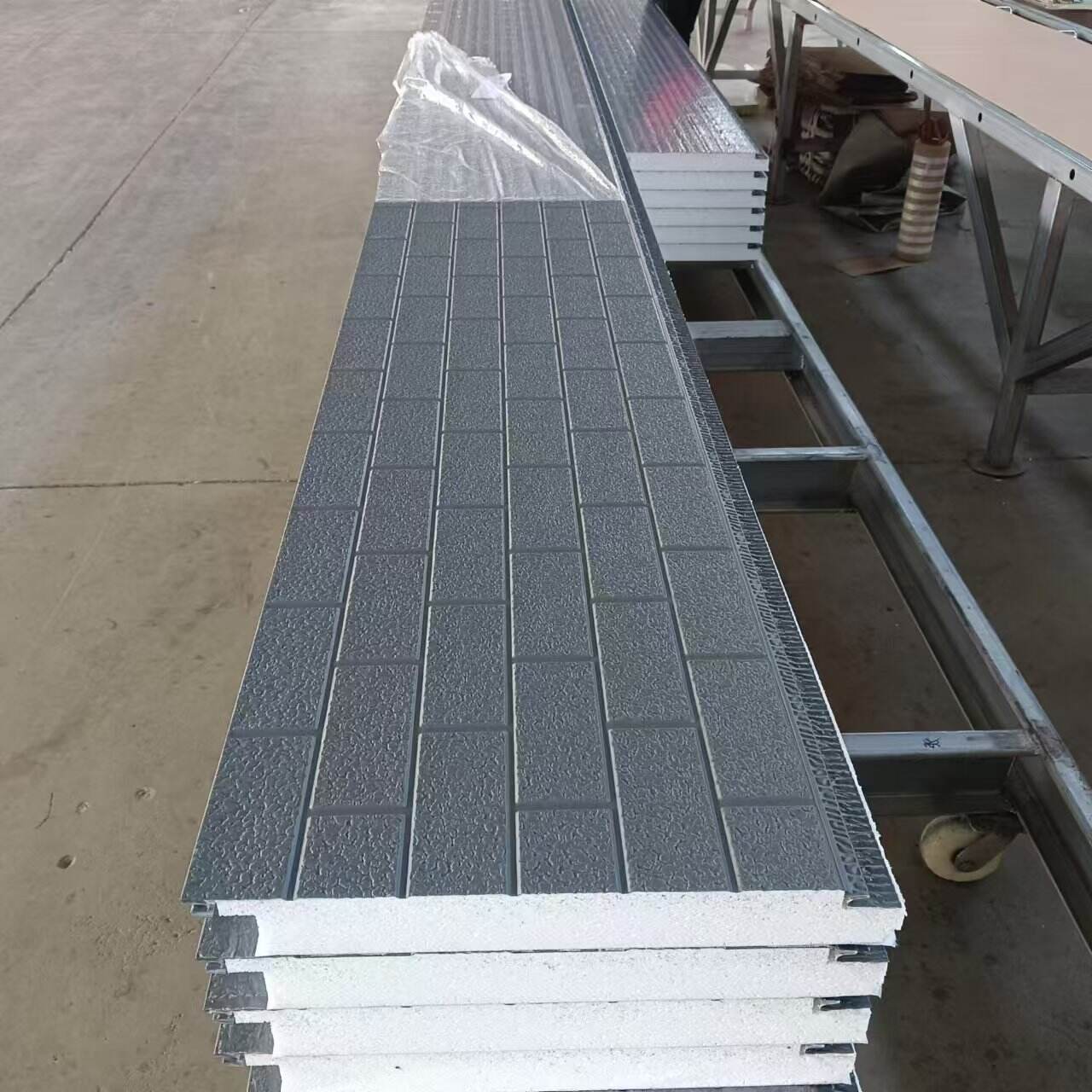What Makes Rock Wool Sandwich Panels Essential for Fire Resistance
Mineral Wool Core: The Non-Combustible Backbone
The mineral wool core is a vital component that ensures the superior fire resistance of rock wool sandwich panels. Comprising natural minerals and rocks that are melted and spun into fibers, mineral wool is engineered to withstand high temperatures without melting or igniting. This unique composition makes it an essential choice in buildings where fire safety is paramount. Non-combustibility is particularly crucial for commercial and industrial constructions as it significantly limits fire-related damage, offering an added layer of safety. Studies have shown that mineral wool insulation can resist temperatures up to 1000°C, outperforming many other insulation materials in terms of fire resistance. This makes it highly valuable in maintaining structural integrity during a fire incident, protecting both property and lives.
A1 Fire Rating Explained: Meeting Global Safety Standards
An A1 fire rating is a classification that signifies the highest level of fire safety a material can attain. This rating, established through rigorous testing, ensures that the material, in this case, rock wool, will not contribute to a fire in any stage, whether during the initial flashover or as the fire progresses. Many global safety standards, such as those in the European Union and parts of Australia, mandate the use of A1-rated materials in high-risk environments like commercial complexes and industrial sites. Expert opinions and statistical analyses underscore that using A1-rated materials considerably reduces fire-related risks, leading to enhanced safety levels. This high level of fire safety is critical for builders who prioritize protecting their projects from potential fire disasters.
Delaying Structural Collapse During Flashover Events
Understanding the phenomenon of flashover is crucial in comprehending the importance of fire-resistant construction materials. Flashover refers to a point where all combustible materials in a room ignite almost simultaneously due to extreme heat, often leading to catastrophic structural failures. Rock wool sandwich panels play a critical role in such scenarios by providing a barrier that helps delay the spread of flames and heat. Their robust performance under extreme conditions means they can significantly extend the time available for safe evacuation and emergency response. Case studies from various fire incidents highlight how the strategic use of rock wool panels minimized damage by preventing rapid structural collapse. This ability to delay catastrophic failures makes them an invaluable asset in high-stakes construction environments where safety is non-negotiable.
Superior Thermal Insulation & Acoustic Performance
How Mineral Wool Traps Heat in Extreme Temperatures
Mineral wool in rock wool sandwich panels provides remarkable thermal insulation, trapping heat even in extreme temperatures. This material has low thermal conductivity making it ideal for maintaining consistent indoor temperatures. Consequently, using mineral wool reduces the reliance on heating systems, which enhances the building's energy efficiency while cutting down energy costs. According to studies, buildings employing rock wool panels can show a significant reduction in heating expenses, with some estimates suggesting up to a 25% decrease in energy costs.
STC Ratings: Sound Dampening for Industrial Environments
In industrial environments, soundproofing is critical, and this is where STC (Sound Transmission Class) ratings become relevant. STC ratings measure how effectively a material can reduce sound transmission, and mineral wool's density makes it an ideal candidate for boosting these ratings. As a result, rock wool sandwich panels are instrumental in minimizing noise pollution in industrial settings. Insights from acoustic engineering experts emphasize how these panels help in creating a quieter and more conducive working environment, thereby enhancing overall productivity and worker satisfaction.

Energy Efficiency Meets Noise Control in One System
Rock wool sandwich panels offer a dual advantage of bolstering energy efficiency and controlling noise within buildings. Businesses adopting these panels have reported improved energy savings alongside notable reductions in indoor noise levels. For example, one report highlighted that an industrial facility managed to cut its energy consumption by 30%, while also achieving a more serene work environment. Moreover, the reduction in energy usage aligns with broader environmental goals by decreasing greenhouse gas emissions, making rock wool panels an ideal choice for those seeking sustainable building solutions.
Structural Integrity Meets Installation Efficiency
High Mass/Low Weight Paradox: Crane-Ready Panels
Rock wool sandwich panels manage to achieve high structural integrity while minimizing weight, which is a major advantage for construction projects. The unique composition of these panels allows them to be both lightweight and strong, ideal for crane installations at sites. This balance facilitates easier transportation and reduces installation costs significantly. Numerous construction companies have successfully implemented these crane-ready panels, reporting decreased labor costs and faster project completion times. For instance, a leading construction firm noted a 20% reduction in their project budget due to the ease of handling and swift assembly provided by these panels. By choosing rock wool sandwich panels, the construction sector can enhance efficiency and reduce expenses.
Durable Facing Materials for Weather & Impact Resistance
The facing materials used in sandwich panels play a crucial role in ensuring their longevity and performance. Typically, these materials include metals like aluminum or galvanized steel, chosen for their robustness and resistance to environmental factors. These facings enhance the panels' ability to withstand extreme weather conditions and physical impacts, such as wind, rain, and hail, which are common challenges in construction. Data from durability tests highlight that panels with these sturdy facings retain their integrity over decades, significantly outlasting many traditional building materials. In a study focusing on coastal constructions, panels with durable facings maintained their protective properties even after prolonged exposure to intense environmental stress, underscoring their reliability and value in harsh climates.
Prefabrication Advantages Over Traditional Masonry
Prefabrication offers significant advantages over traditional masonry in terms of construction timelines and cost savings. This method involves producing components off-site in a controlled environment, which ensures higher precision and consistent quality. Prefabrication not only speeds up the construction process by reducing onsite labor requirements but also minimizes waste and error margins, translating into substantial cost efficiencies. Experts in the field have remarked on the superior long-term performance of prefabricated structures, highlighting their resilience and reduced maintenance needs compared to masonry. An industry leader shared insights noting that their prefabricated buildings reported maintenance costs that were 15% lower than those of traditional buildings, demonstrating the economic and operational benefits of this modern construction approach.
Airport Curtain Walls: Fire Containment Strategies
Rock wool sandwich panels are vital in enhancing fire containment within airport curtain walls. These panels are designed to withstand extreme temperatures due to the fire-resistant properties of rock wool, capable of enduring heat up to 1,000°C without succumbing to flames. They meet stringent aviation safety regulations, ensuring airports remain safe zones amidst potential fire hazards. Many airports have already implemented these systems to heighten safety, including those in regions prone to high temperatures or frequent air traffic. For instance, Dubai International Airport has integrated rock wool sandwich panels as part of its expansive safety measures to protect against fire-related incidents.
Data Center Protection: Stopping Thermal Runaway
In data centers, prevention of thermal runaway is crucial for maintaining data integrity and equipment functionality. Rock wool sandwich panels play a significant role in averting this phenomenon by offering superior thermal regulation, which helps maintain stable temperature environments. These panels' excellent insulation properties minimize the risk of overheating, thus safeguarding sensitive electronic components. Statistics indicate that data centers utilizing robust insulation materials like rock wool experience fewer instances of thermal runaway, exemplifying the importance of selecting appropriate barriers to protect against this risk. Their ability to maintain consistent temperatures ensures both equipment longevity and efficient operation.
Manufacturing Plants: Combining OSHA Compliance with Workflow
Rock wool sandwich panels assist manufacturing facilities in seamlessly meeting OSHA requirements while optimizing workflow. These panels not only provide superior acoustic and thermal insulation but also contribute to a safer and more comfortable environment for workers. Improved sound and thermal control enhance employee concentration and efficiency, fostering positive work conditions. Employers have reported increased employee satisfaction and notable safety enhancements after integrating these panels into their plants. Not only do they help maintain compliance with safety regulations, but they also contribute to an efficient work environment that prioritizes both worker safety and productivity improvement.
Meeting Modern Construction Demands
LEED Certification Through Recycled Content
Rock wool sandwich panels significantly contribute to LEED certification by incorporating recycled materials, aligning with sustainable construction practices emphasized in today's market. By utilizing recycled content, these panels help projects achieve points towards LEED certification, supporting an industry-wide move towards greener building solutions. The use of environmentally friendly materials has led to an increase in LEED-certified projects, as documented in various studies and market reports. This trend not only highlights the importance of sustainable practices but also reflects a shift in stakeholder demand for construction solutions that minimize environmental impact while maintaining quality and performance.
Retrofitting Historic Buildings Without Compromising Safety
Retrofitting historic structures presents unique challenges, including preserving the architectural integrity while enhancing safety features. Rock wool panels are ideal for addressing these challenges as they provide superior fire resistance and insulation without compromising the structure's historic charm. Successful retrofitting projects, such as the renovation of historic hotels and government buildings, showcase their effectiveness in maintaining safety standards. Additionally, governments and heritage organizations often offer grants or incentives to encourage the use of modern, safe materials like rock wool in historic renovations, further facilitating this transition.
Seismic Performance in Multi-Story Designs
Rock wool sandwich panels are engineered to perform excellently under seismic conditions, making them crucial for multi-story buildings in earthquake-prone regions. These panels provide robust structural support and energy dissipation, reducing the building's sway during seismic activities. It's essential to choose suitable materials for multi-story designs to ensure structural integrity and occupant safety. Engineering studies underscore the impressive seismic resilience of these panels, thereby reinforcing their role in modern architecture where safety and durability are paramount. As urban landscapes continue to evolve, incorporating such advanced materials becomes ever more critical.
FAQ
What are rock wool sandwich panels?
Rock wool sandwich panels are composite building materials made of a core of mineral wool sandwiched between two outer layers, often used for fire-resistant, thermal, and acoustic insulation in construction.
Why is mineral wool used in rock wool sandwich panels for fire resistance?
Mineral wool is non-combustible and can withstand high temperatures up to 1000°C without melting or igniting, making it ideal for fire-resistant applications.
How do rock wool sandwich panels contribute to energy efficiency?
These panels offer excellent thermal insulation due to their low thermal conductivity, reducing the need for heating systems and thus lowering energy costs.
Can rock wool sandwich panels be used in historic building renovations?
Yes, they provide enhanced safety and insulation without compromising the architectural integrity of historic buildings.
Are rock wool sandwich panels suitable for use in seismic zones?
Yes, they are engineered to provide structural support and energy dissipation, reducing sway and enhancing safety in seismic regions.
Table of Contents
- What Makes Rock Wool Sandwich Panels Essential for Fire Resistance
- Superior Thermal Insulation & Acoustic Performance
- Structural Integrity Meets Installation Efficiency
- Airport Curtain Walls: Fire Containment Strategies
- Data Center Protection: Stopping Thermal Runaway
- Manufacturing Plants: Combining OSHA Compliance with Workflow
- Meeting Modern Construction Demands
-
FAQ
- What are rock wool sandwich panels?
- Why is mineral wool used in rock wool sandwich panels for fire resistance?
- How do rock wool sandwich panels contribute to energy efficiency?
- Can rock wool sandwich panels be used in historic building renovations?
- Are rock wool sandwich panels suitable for use in seismic zones?

 EN
EN







































